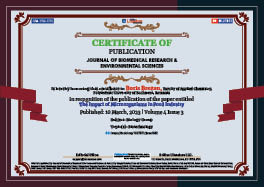Biology Group . 2023 March 10;4(2):348-349. doi: 10.37871/jbres1682.
The Impact of Microorganisms in Food Industry
Boris Brezan*
- Microorganisms
- Food
- Biomass
Abstract
Microorganisms occupy an important role in the food industry, which is otherwise unthinkable without their existence, the roles in which they are involved ranging from conservation operations to obtaining food products due to their fermentative action.
They form a vast and special group in terms of morphology, but especially in terms of biological activity, which can include bacteria, microscopic fungi (e.g. yeasts, molds), viruses and protozoa.
It is also the reason why the discussions on this topic are perceived as a sensitive topic and having a negative impact, precisely because unfavorable effects may appear on the population health.
Introduction
A classification of the products resulting from the action of microorganisms divides them into cells and biomass, primary and secondary metabolites and enzymes.
Summary
Bacteria, present in almost all natural ecosystems, were the subject of discussions that later led to the initiation of microscopic investigation techniques and implicitly to the establishment of the science of microbiology.
The topics related to spontaneous generation, respectively the nature of certain contagious diseases, were clarified. The existence of spontaneous generation is correlated with unfavorable food storage conditions, which facilitate the latter's entry into a state of putrefaction. Later, microscopic investigations can lead to the identification of a large number of bacteria.
However, the question arises related to their origin, since they are not found in fresh foods?
Studies have demonstrated the existence of these microscopic bodies on all objects in the environment, which is why the microorganisms from decaying matter originate in the air.
Such considerations have led over time to the development of sterilization techniques, being analyzed and compared solutions such as the boiling operation using different application times depending on the application environment.
On the other hand, many of the food products are consumed together with the cells of the microorganisms used in the production process, being included here the microorganisms used for fermentation operations (e.g. fermented cheeses, bread, fermented meat or vegetable products).
In other cases only the fermented medium is consumed, the cells being removed. Can be included here the alcoholic beverages such as cider, beer, wine.
Conclusion
It is certain that among the conditions to be met by a starter culture of microorganisms obtained from a selected strain in order to be used in a certain area of the food industry, is that of being biologically pure.
It can be reused by mixing a starter culture with a biomass separated from a previous process (e.g. a previous fermentation), this being impetuously necessary to meet the same aseptic conditions.
The contamination of the biomass with the infectious microorganism influences the number of reuses, as well as the adjacent operations of isolation and preservation of cultures, not only at the laboratory level (still in the state of propagation) but especially at the industrial level (production culture room).
There are also situations where the naturally existing microflora (e.g. yeasts, bacteria, molds) and involved in certain processes, undergo a selection, the more sensitive being the one that does not tolerate high acidity, but not always the environments are in this way.
So, ensuring aseptic conditions throughout the process chain is mandatory above all, correlated with a plan of measures and control.
Content Alerts
SignUp to our
Content alerts.
 This work is licensed under a Creative Commons Attribution 4.0 International License.
This work is licensed under a Creative Commons Attribution 4.0 International License.








